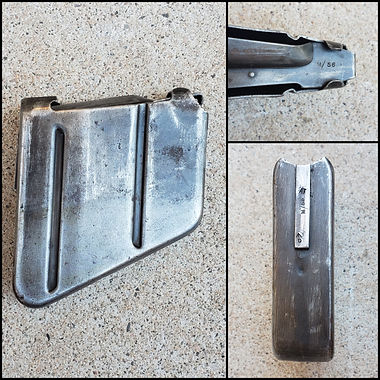
SMLE
NO.1 MK.III*
Britain
A BRIEF OVERALL HISTORY
The Short, Magazine Lee-Enfield (SMLE), or Rifle No.1 as it would be later designated, entered British service in 1904. Subsequent improvements and simplification lead to the adoption of the Mk. III* in 1915. The Mk. III* was a wartime simplification of the Mk. III, with the most notable changes being the deletion of the magazine cut off and the volley sights. The Mk. III* was the final full production variation of the SMLE and saw service in WWI, WWII, and beyond.

CYPHER, FACTORY NAME, YEAR OF MANUFACTURE, MODEL AND MARK
On the right side of the buttstock socket, from top to bottom we have the crown (or Cypher) of Georgius Rex (King George V) indicating the rifle was produced under his rule. "Enfield" indicates the rifle was produced at the Royal Small Arms Factory (RSAF) Enfield and is followed by the year of production, 1916. "ShtLE" is an abbreviation for Short Lee-Enfield and this is followed by the III*, which is the Mark variation.

SERIAL NUMBER
The Serial Number is located on the right side of the receiver ring. RSAF Enfield used 4 digits (other manufacturers used 5 digits) and a letter suffix, repeating every year. With an S prefix, this was about the 196,800th rifle produced by RSAF Enfield in 1916.

BOLT HEAD
The bolt head is factory marked MA 53, indicating it was produced by Lithgow Small Arms Factory in Australia in 1953. The electro pencil markings of P and SO are an unknown.

REAR SIGHT
Another simplification of the Mk. III* variation was the deletion of the windage adjustment on rear sight. This is what is considered the third variation rear sight. It is still graduated out to 2000 yards but the windage screw along with the windage graduations are omitted. Note the protective ear has not been modified from previous Mks and is off set to the right to accommodate the windage screw which is not present.

PROOF MARK
The largest of the marks on the front left side of the receiver ring is a proof mark. This mark consists of the same cypher as on the buttstock socket, above crossed flags with a "P" below. This indicates it was proofed in England as a land service rifle.

MAGAZINE
The magazine with this rifle is actually a No.4 Mk.1 magazine. It is Marked M/56 which indicates it was produced by Cheney & Son Ltd of Willenham.

IMPORT MARK
On the left side of the receiver is an import mark, "CAI ST. ALB. VT MK3 303 UK". The rifle was imported by Century Arms International (CAI), located in St. Albans, VT. Century arms started importing firearms in the 1960's and moved from St. Albans in 2000, indicating the rifle was imported during that time frame. Interesting to note, they identified it was a MK3 and did not worry about the * designation. It is chambered in .303 British and was imported from the United Kingdom.

STOCK DISC
The British often marked rifles with brass discs in set in to the stocks to identify units. This stock does not have a stock disc but it does have one painted on. Whoever did this took some time to do it as it nicely done and from a far it is easily mistaken as an actual stock disc.













